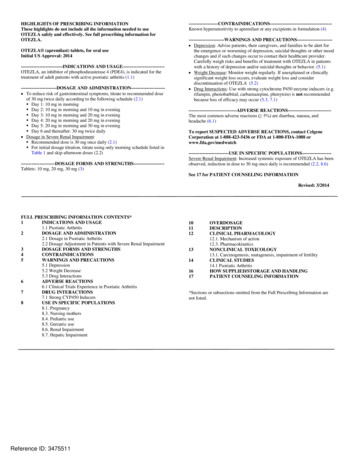
Transcription
HIGHLIGHTS OF PRESCRIBING INFORMATIONThese highlights do not include all the information needed to useOTEZLA safely and effectively. See full prescribing information forOTEZLA.OTEZLA (apremilast) tablets, for oral useInitial US Approval: 2014---------------------------INDICATIONS AND USAGE-------------------------- OTEZLA, an inhibitor of phosphodieasterase 4 (PDE4), is indicated for thetreatment of adult patients with active psoriatic arthritis (1.1)-----------------------DOSAGE AND ADMINISTRATION--------------------- To reduce risk of gastrointestinal symptoms, titrate to recommended doseof 30 mg twice daily according to the following schedule (2.1) Day 1: 10 mg in morning Day 2: 10 mg in morning and 10 mg in evening Day 3: 10 mg in morning and 20 mg in evening Day 4: 20 mg in morning and 20 mg in evening Day 5: 20 mg in morning and 30 mg in evening Day 6 and thereafter: 30 mg twice daily Dosage in Severe Renal Impairment: Recommended dose is 30 mg once daily (2.1) For initial dosage titration, titrate using only morning schedule listed inTable 1 and skip afternoon doses (2.2)----------------------DOSAGE FORMS AND STRENGTHS------------------- Tablets: 10 mg, 20 mg, 30 mg ---------------------------- Known hypersensitivity to apremilast or any excipients in formulation (4)-----------------------WARNINGS AND PRECAUTIONS---------------------- Depression: Advise patients, their caregivers, and families to be alert forthe emergence or worsening of depression, suicidal thoughts or other moodchanges and if such changes occur to contact their healthcare provider.Carefully weigh risks and benefits of treatment with OTEZLA in patientswith a history of depression and/or suicidal thoughts or behavior. (5.1) Weight Decrease: Monitor weight regularly. If unexplained or clinicallysignificant weight loss occurs, evaluate weight loss and considerdiscontinuation of OTEZLA (5.2) Drug Interactions: Use with strong cytochrome P450 enzyme inducers (e.g.rifampin, phenobarbital, carbamazepine, phenytoin) is not recommendedbecause loss of efficacy may occur (5.3, 7.1)-------------------------------ADVERSE REACTIONS--------------------------- The most common adverse reactions ( 5%) are diarrhea, nausea, andheadache (6.1)To report SUSPECTED ADVERSE REACTIONS, contact CelgeneCorporation at 1-888-423-5436 or FDA at 1-800-FDA-1088 E IN SPECIFIC POPULATIONS------------------ Severe Renal Impairment: Increased systemic exposure of OTEZLA has beenobserved, reduction in dose to 30 mg once daily is recommended (2.2, 8.6)See 17 for PATIENT COUNSELING INFORMATIONRevised: 3/2014FULL PRESCRIBING INFORMATION CONTENTS*1INDICATIONS AND USAGE1.1 Psoriatic Arthritis2DOSAGE AND ADMINISTRATION2.1 Dosage in Psoriatic Arthritis2.2 Dosage Adjustment in Patients with Severe Renal Impairment3DOSAGE FORMS AND STRENGTHS4CONTRAINDICATIONS5WARNINGS AND PRECAUTIONS5.1 Depression5.2 Weight Decrease5.3 Drug Interactions6ADVERSE REACTIONS6.1 Clinical Trials Experience in Psoriatic Arthritis7DRUG INTERACTIONS7.1 Strong CYP450 Inducers8USE IN SPECIFIC POPULATIONS8.1. Pregnancy8.3. Nursing mothers8.4. Pediatric use8.5. Geriatric use8.6. Renal Impairment8.7. Hepatic ImpairmentReference ID: 347551110111213141617OVERDOSAGEDESCRIPTIONCLINICAL PHARMACOLOGY12.1. Mechanism of action12.3. PharmacokineticsNONCLINICAL TOXICOLOGY13.1. Carcinogenesis, mutagenesis, impairment of fertilityCLINICAL STUDIES14.1 Psoriatic ArthritisHOW SUPPLIED/STORAGE AND HANDLINGPATIENT COUNSELING INFORMATION*Sections or subsections omitted from the Full Prescribing Information arenot listed.
FULL PRESCRIBING INFORMATION1INDICATIONS AND USAGE1.1Psoriatic ArthritisOTEZLA is indicated for the treatment of adult patients with active psoriatic arthritis.2DOSAGE AND ADMINISTRATION2.1Dosage in Psoriatic ArthritisThe recommended initial dosage titration of OTEZLA from Day 1 to Day 5 is shown in Table 1. Following the 5-day titration, therecommended maintenance dosage is 30 mg twice daily taken orally starting on Day 6. This titration is intended to reduce thegastrointestinal symptoms associated with initial therapy.OTEZLA can be administered without regard to meals. Do not crush, split, or chew the tablets.Table 1: Dosage Titration ScheduleDay 1AM10 mg2.2Day2AM10 mgPM10 mgDay 3AM10 mgPM20 mgDay 4AM20 mgPM20 mgDay 6& thereafterDay 5AM20 mgPM30 mgAM30 mgPM30 mgDosage Adjustment in Patients with Severe Renal ImpairmentOTEZLA dosage should be reduced to 30 mg once daily in patients with severe renal impairment (creatinine clearance (CLcr) of less than30 mL per minute estimated by the Cockroft–Gault equation) [see Use in Specific Populations (8.6) and Clinical Pharmacology (12.3)].For initial dosage titration in this group, it is recommended that OTEZLA be titrated using only the AM schedule listed in Table 1 and thePM doses be skipped.3DOSAGE FORMS AND STRENGTHSOTEZLA is available as diamond shaped, film coated tablets in the following dosage strengths:10 mg pink tablet engraved with “APR” on one side and “10” on the other side20 mg brown tablet engraved with “APR” on one side and “20” on the other side30 mg beige tablet engraved with “APR” on one side and “30” on the other side.4CONTRAINDICATIONSOTEZLA is contraindicated in patients with a known hypersensitivity to apremilast or to any of the excipients in the formulation [seeAdverse Reactions (6.1)].5WARNINGS AND PRECAUTIONS5.1 DepressionTreatment with OTEZLA is associated with an increase in adverse reactions of depression. During the 0 to 16 weeks placebo-controlledperiod of the 3 controlled clinical trials, 1.0% (10/998) of patients treated with OTEZLA reported depression or depressed moodcompared to 0.8% (4/495) treated with placebo. During the clinical trials, 0.3% (4/1441) of patients treated with OTEZLA discontinuedtreatment due to depression or depressed mood compared with none in placebo treated patients (0/495). Depression was reported asserious in 0.2% (3/1441) of patients exposed to OTEZLA, compared to none in placebo treated patients (0/495). Instances of suicidalideation and behavior have been observed in 0.2% (3/1441) of patients while receiving OTEZLA, compared to none in placebo treatedpatients (0/495). In the clinical trials, two patients who received placebo committed suicide compared to none in OTEZLA treatedpatients.Before using OTEZLA in patients with a history of depression and/or suicidal thoughts or behavior prescribers should carefully weigh therisks and benefits of treatment with OTEZLA in such patients. Patients, their caregivers, and families should be advised of the need tobe alert for the emergence or worsening of depression, suicidal thoughts or other mood changes, and if such changes occur to contactReference ID: 3475511
their healthcare provider. Prescribers should carefully evaluate the risks and benefits of continuing treatment with OTEZLA if such eventsoccur.5.2 Weight DecreaseDuring the controlled period of the studies, weight decrease between 5-10% of body weight was reported in 10% (49/497) of patientstreated with OTEZLA 30 mg twice daily compared to 3.3% (16/495) treated with placebo [see Adverse Reactions (6.1)]. Patients treatedwith OTEZLA should have their weight monitored regularly. If unexplained or clinically significant weight loss occurs, weight lossshould be evaluated, and discontinuation of OTEZLA should be considered.5.3 Drug InteractionsCo-administration of strong cytochrome P450 enzyme inducer, rifampin, resulted in a reduction of systemic exposure of apremilast,which may result in a loss of efficacy of OTEZLA. Therefore, the use of cytochrome P450 enzyme inducers (e.g. rifampin, phenobarbital,carbamazepine, phenytoin) with OTEZLA is not recommended. [see Drug Interactions (7.1) and Clinical Pharmacology (12.3)].6ADVERSE REACTIONS6.1Clinical Trials Experience in Psoriatic ArthritisBecause clinical trials are conducted under widely varying conditions, adverse reaction rates observed in the clinical trial of a drug cannotbe directly compared to rates in the clinical trials of another drug and may not reflect the rates observed in clinical practice.OTEZLA was evaluated in 3 multicenter, randomized, double-blind, placebo-controlled trials [Studies PsA-1, PsA-2, and PsA-3] ofsimilar design in adult patients with active psoriatic arthritis [see Clinical Studies (14.1)]. Across the 3 studies, there were 1493 patientsrandomized equally to placebo, OTEZLA 20 mg twice daily or OTEZLA 30 mg twice daily. Titration was used over the first 5 days [seeDosage and Administration (2.1)]. Placebo patients whose tender and swollen joint counts had not improved by at least 20% were rerandomized 1:1 in a blinded fashion to either OTEZLA 20 mg twice daily or 30 mg twice daily at week 16 while OTEZLA patientsremained on their initial treatment. Patients ranged in age from 18 to 83 years, with an overall median age of 51 years.The majority of the most common adverse reactions presented in Table 2 occurred within the first two weeks of treatment and tended toresolve over time with continued dosing. Diarrhea, headache, and nausea were the most commonly reported adverse reactions. The mostcommon adverse reactions leading to discontinuation for patients taking OTEZLA were nausea (1.8%), diarrhea (1.8%), and headache(1.2%). The proportion of patients with psoriatic arthritis who discontinued treatment due to any adverse reaction was 4.6% for patientstaking OTEZLA 30 mg twice daily and 1.2% for placebo-treated patients.Table 2: Adverse Reactions Reported in 2% of Patients on OTEZLA 30 mg Twice Daily and 1% Than ThatObserved in Patients on Placebo For Up To Day 112 ( Week 16)PlaceboOTEZLA 30 mg BIDDay 6 to Day 112(N 490)n (%)Day 1 to 5(N 497)n (%)Day 6 to Day 112(N 493)n (%)6 ( 1.2)8 ( 1.6)46 ( 9.3)38 ( 7.7)7 ( 1.4)15 ( 3.1)37 ( 7.4)44 ( 8.9)Headachea9 ( 1.8)11 ( 2.2)24 ( 4.8)29 ( 5.9)Upper respiratory tractinfectionb3 ( 0.6)9 ( 1.8)3 ( 0.6)19 ( 3.9)Vomitinga2 ( 0.4)2 ( 0.4)4 ( 0.8)16 ( 3.2)1 ( 0.2)8 ( 1.6)1 ( 0.2)13 ( 2.6)Day 1 to 5(N 495)n (%)cPreferred TermDiarrhea aNauseaaNasopharyngitisbbAbdominal pain upper0 ( 0.0)1 ( 0.2)3 ( 0.6)10 ( 2.0)Of the reported gastrointestinal adverse reactions, 1 subject experienced a serious adverse reaction of nausea and vomiting inOTEZLA 30 mg twice daily; 1 subject treated with OTEZLA 20 mg twice daily experienced a serious adverse reaction ofdiarrhea; 1 patient treated with OTEZLA 30 mg twice daily experienced a serious adverse reaction of headache.bOf the reported adverse drug reactions none were serious.cn (%) indicates number of patients and percent.aReference ID: 3475511
Other adverse reactions reported in patients on OTEZLA in clinical studies including extension studies:Immune system disorders: HypersensitivityInvestigations: Weight decreaseGastrointestinal Disorders: Frequent bowel movement, Gastroesophageal reflux disease, DyspepsiaMetabolism and Nutrition Disorders: Decreased appetite*Nervous System Disorders: MigraineRespiratory, Thoracic, and Mediastinal Disorders: CoughSkin and Subcutaneous Tissue Disorders: Rash*1 patient treated with OTEZLA 30 mg twice daily experienced a serious adverse reaction.7DRUG INTERACTIONS7.1 Strong CYP 450 InducersApremilast exposure is decreased when OTEZLA is co-administered with strong CYP450 inducers (such as rifampin) and may result inloss of efficacy [see Warnings and Precautions (5.3) and Clinical Pharmacology (12.3)].8USE IN SPECIFIC POPULATIONS8.1 PregnancyPregnancy Category C:Pregnancy Exposure RegistryThere is a pregnancy exposure registry that monitors pregnancy outcomes in women exposed to OTEZLA during pregnancy. Informationabout the registry can be obtained by calling 1-877-311-8972.Risk SummaryAdequate and well-controlled studies with OTEZLA have not been conducted in pregnant women. In animal embryo-fetal developmentstudies, the administration of apremilast to cynomolgus monkeys during organogenesis resulted in dose-related increases inabortion/embryo-fetal death at dose exposures 2.1-times the maximal recommended human therapeutic dose (MRHD) and no adverseeffect at an exposure of 1.4-times the MRHD. In mice, there were no apremilast induced malformations up to exposures 4.0-times theMRHD. The incidences of malformations and pregnancy loss in human pregnancies have not been established for OTEZLA. However,all pregnancies, regardless of drug exposure, have a background rate of 2 to 4% for major malformations, and 15 to 20% for pregnancyloss. OTEZLA should be used during pregnancy only if the potential benefit justifies the potential risk to the fetus.Clinical ConsiderationsLabor or deliveryThe effects of OTEZLA on labor and delivery in pregnant women are unknown. In mice, dystocia was noted at doses corresponding to 4.0-times the MRHD (on an AUC basis at doses 80 mg/kg/day) of apremilast.Animal DataMonkey embryo-fetal development: In an embryo-fetal developmental study, cynomolgus monkeys were administered apremilast at dosesof 20, 50, 200, or 1000 mg/kg/day during the period of organogenesis (gestation days 20 through 50). There was a dose-related increase inspontaneous abortions, with most abortions occurring during weeks 3 to 4 of dosing in the first trimester, at doses approximately 2.1 times the MRHD and greater (on an AUC basis at doses 50 mg/kg/day). No abortifacient effects were observed at a dose approximately1.4-times the MRHD (on an AUC basis at a dose of 20 mg/kg/day). Although, there was no evidence for a teratogenic effect at doses of20 mg/kg/day and greater when examined at day 100, aborted fetuses were not examined.Mouse embryo-fetal development: In an embryo-fetal development study, apremilast was administered at dosages of 250, 500, or 750mg/kg/day to dams during organogenesis (gestation day 6 through 15). In a combined fertility and embryo-fetal development study,apremilast was administered at dosages of 10, 20, 40 or 80 mg/kg/day starting 15 days before cohabitation and continuing throughgestation day 15. No teratogenic findings attributed to apremilast were observed in either study; however, there was an increase inpostimplantation loss at doses corresponding to a systemic exposure of 2.3-times the MRHD and greater ( 20 mg/kg/day). At doses of 20 mg/kg/day skeletal variations included incomplete ossification sites of tarsals, skull, sternebra, and vertebrae. No effects wereobserved at a dose approximately 1.3-times the MRHD (10 mg/kg/day).Mouse pre- and postnatal development: In a pre- and postnatal study in mice, apremilast was administered to pregnant female mice atdoses of 10, 80, or 300 mg/kg/day from day 6 of gestation through day 20 of lactation, with weaning on day 21. Dystocia, reducedviability, and reduced birth weights occurred at doses corresponding to 4.0-times the MRHD (on an AUC basis at doses 80 mg/kg/day).No adverse effects occurred at a dose 1.3-times the MRHD (10 mg/kg/day). There was no evidence for functional impairment of physicaldevelopment, behavior, learning ability, immune competence, or fertility in the offspring at doses up to 7.5-times the MRHD (on an AUCbasis at a dose of 300 mg/kg/day).Reference ID: 3475511
8.3 Nursing MothersIt is not known whether OTEZLA or its metabolites are present in human milk; however apremilast was detected in milk of lactatingmice. Because many drugs are present in human milk, caution should be exercised when OTEZLA is administered to a nursing woman.8.4 Pediatric useThe safety and effectiveness of OTEZLA in pediatric patients less than18 years of age have not been established.8.5 Geriatric useOf the 1493 patients who enrolled in Studies PsA-1, PsA-2, and PsA-3 a total of 146 psoriatic arthritis patients were 65 years of age andolder, including 19 patients 75 years and older. No overall differences were observed in the safety profile of elderly patients 65 years ofage and younger adult patients 65 years of age in the clinical studies.8.6 Renal ImpairmentOTEZLA pharmacokinetics were not characterized in subjects with mild (creatinine clearance of 60-89 mL per minute estimated by theCockroft–Gault equation) or moderate(creatinine clearance of 30-59 mL per minute estimated by the Cockroft–Gault equation) renalimpairment. The dose of OTEZLA should be reduced to 30 mg once daily in patients with severe renal impairment (creatinine clearanceof less than 30 mL per minute estimated by the Cockroft–Gault equation) [see Dosage and Administration (2.2) and ClinicalPharmacology (12.3)].8.7 Hepatic ImpairmentApremilast pharmacokinetics were characterized in subjects with moderate (Child Pugh B) and severe (Child Pugh C) hepaticimpairment. No dose adjustment is necessary in these patients.10OVERDOSAGEIn case of overdose, patients should seek immediate medical help. Patients should be managed by symptomatic and supportive careshould there be an overdose.11DESCRIPTIONThe active ingredient in OTEZLA tablets is apremilast. Apremilast is a phosphodiesterase 4 (PDE4) inhibitor. Apremilast is knownchemically as -yl]acetamide. Itsempirical formula is C22H24N2O7S and the molecular weight is 460.5.The chemical structure is:OOONONHOHS OOOTEZLA tablets are supplied in 10, 20, and 30 mg strengths for oral administration. Each tablet contains apremilast as the activeingredient and the following inactive ingredients: lactose monohydrate, microcrystalline cellulose, croscarmellose sodium, magnesiumstearate, polyvinyl alcohol, titanium dioxide, polyethylene glycol, talc, iron oxide red, iron oxide yellow (20 and 30 mg only) and ironoxide black (30 mg only).12CLINICAL PHARMACOLOGY12.1 Mechanism of actionApremilast is an oral small-molecule inhibitor of phosphodiesterase 4 (PDE4) specific for cyclic adenosine monophosphate (cAMP).Reference ID: 3475511
PDE4 inhibition results in increased intracellular cAMP levels. The specific mechanism(s) by which apremilast exerts its therapeuticaction in psoriatic arthritis patients is not well defined.12.3 PharmacokineticsAbsorptionApremilast when taken orally is absorbed with an absolute bioavailability of 73%, with peak plasma concentrations (Cmax) occurring at amedian time (tmax) of 2.5 hours. Co-administration with food does not alter the extent of absorption of apremilast.DistributionHuman plasma protein binding of apremilast is approximately 68%. Mean apparent volume of distribution (Vd) is 87 L.MetabolismFollowing oral administration in humans, apremilast is a major circulating component (45%) followed by inactive metabolite M12 (39%),a glucuronide conjugate of O-demethylated apremilast. It is extensively metabolized in humans with up to 23 metabolites identified inplasma, urine and feces. Apremilast is metabolized by both cytochrome (CYP) oxidative metabolism with subsequent glucuronidation andnon-CYP mediated hydrolysis. In vitro, CYP metabolism of apremilast is primarily mediated by CYP3A4, with minor contributions fromCYP1A2 and CYP2A6.EliminationThe plasma clearance of apremilast is about 10 L/hr in healthy subjects, with a terminal elimination half-life of approximately 6-9 hours.Following oral administration of radio-labeled apremilast, about 58% and 39% of the radioactivity is recovered in urine and feces,respectively, with about 3% and 7% of the radioactive dose recovered as apremilast in urine and feces, respectively.Specific PopulationsHepatic Impairment: The pharmacokinetics of apremilast is not affected by moderate or severe hepatic impairment.Renal Impairment: In 8 subjects with severe renal impairment administered a single dose of 30 mg apremilast, the AUC and Cmax ofapremilast increased by approximately 88% and 42%, respectively. [see Use in Specific Populations (8.6) and Dosage andAdministration (2.2)].Age: A single oral dose of 30mg apremilast was studied in young adults and elderly healthy subjects. The apremilast exposure in elderlysubjects (65 to 85 years of age) was about 13% higher in AUC and about 6% higher in Cmax than in young subjects (18 to 55 years of age).[see Use in Specific Populations (8.5)].Gender: In pharmacokinetic studies in healthy volunteers, the extent of exposure in females was about 31% higher and Cmax was about8% higher than that in male subjects.Race and Ethnicity: The pharmacokinetics of apremilast in Chinese and Japanese healthy male subjects is comparable to that in Caucasianhealthy male subjects. In addition, apremilast exposure is similar among Hispanic Caucasians, non-Hispanic Caucasians, and AfricanAmericans.Drug InteractionsIn vitro data: Apremilast is not an inhibitor of CYP1A2, CYP2A6, CYP2B6, CYP2C8, CYP2C9, CYP2C19, CYP2D6, CYP2E1, orCYP3A4 and not an inducer of CYP1A2, CYP2B6, CYP2C9, CYP2C19, or CYP3A4. Apremilast is a substrate, but not an inhibitor of P glycoprotein (P-gp) and is not a substrate or an inhibitor of organic anion transporter (OAT)1 and OAT3, organic cation transporter(OCT)2, organic anion transporting polypeptide (OATP)1B1 and OATP1B3, or breast cancer resistance protein (BCRP).Drug interaction studies were performed with apremilast and CYP3A4 substrates (oral contraceptive containing ethinyl estradiol andnorgestimate), CYP3A and P-gp inhibitor (ketoconazole), CYP 450 inducer (rifampin) and frequently co-administered drug in this patientpopulation (methotrexate).No significant pharmacokinetic interactions were observed when 30 mg oral apremilast was administered with either oral contraceptive,ketoconazole, or methotrexate. Co-administration of the CYP450 inducer rifampin (600 mg once daily for 15 days) with a single oral doseof 30 mg apremilast resulted in reduction of apremilast AUC and Cmax by 72% and 43%, respectively. [see Warnings and Precautions(5.3) and Drug Interactions (7.1)].13NONCLINICAL TOXICOLOGY13.1Carcinogenesis, mutagenesis, impairment of fertilityLong-term studies were conducted in mice and rats with apremilast to evaluate its carcinogenic potential. No evidence of apremilast induced tumors was observed in mice at oral doses up to 8.8 the MRHD on an AUC basis (1000 mg/kg/day) or in rats at oral doses up toapproximately 0.08- and 1.1-times the MRHD, (20 mg/kg/day in males and 3 mg/kg/day in females, respectively).Reference ID: 3475511
Apremilast tested negative in the Ames assay, in vitro chromosome aberration assay of human peripheral blood lymphocytes, and the invivo mouse micronucleus assay.In a fertility study of male mice, apremilast at oral dosages up to approximately 3-times the MRHD based AUC (up to 50 mg/kg/day)produced no effects on male fertility. In a fertility study of female mice, apremilast was administered at oral dosages of 10, 20, 40, or 80mg/kg/day. At dosages 1.8-times the MRHD ( 20 mg/kg/day), estrous cycles were prolonged, due to lengthening of diestrus whichresulted in a longer interval until mating. Mice that became pregnant at dosages of 20 mg/kg/day and greater also had increasedincidences of early postimplantation losses. There was no effect of apremilast approximately 1.0-times the MRHD (10 mg/kg/day).14CLINICAL STUDIES14.1 Clinical Studies in Patients with Psoriatic ArthritisThe safety and efficacy of OTEZLA was evaluated in 3 multi-center, randomized, double-blind, placebo-controlled trials (Studies PsA-1,PsA-2, and PsA-3) of similar design. A total of 1493 adult patients with active PsA ( 3 swollen joints and 3 tender joints) despite prioror current treatment with disease-modifying antirheumatic drug (DMARD) therapy were randomized. Patients enrolled in these studieshad a diagnosis of PsA for at least 6 months. One qualifying psoriatic skin lesion of at least 2 cm in diameter was required in Study PsA 3. Previous treatment with a biologic, including TNF-blockers was allowed (up to 10% could be TNF-blocker therapeutic failures).Across the 3 studies, patients were randomly assigned to placebo (n 496), OTEZLA 20 mg (n 500), or OTEZLA 30 mg (n 497)given orally twice daily. Titration was used over the first 5 days [see Dosage and Administration (2.1)] Patients were allowed to receivestable doses of concomitant methotrexate [MTX ( 25 mg/week)], sulfasalazine [SSZ ( 2 g/day)], leflunomide [LEF ( 20 mg/day)], lowdose oral corticosteroids (equivalent to 10 mg of prednisone a day), and/or nonsteroidal anti-inflammatory drugs (NSAIDs) during thetrial. Treatment assignments were stratified based on small-molecule DMARD use at baseline in Studies PsA-1, PsA-2 and PsA-3. Therewas an additional stratification of BSA 3% with psoriasis in study PsA- 3. The patients who were therapeutic failures of 3 agents forPsA (small molecules or biologics), or 1 biologic TNF blocker were excluded.The primary endpoint was the percentage of patients achieving American College of Rheumatology (ACR) 20 response at Week 16.Placebo-controlled efficacy data were collected and analyzed through Week 24. Patients whose tender and swollen joint counts had notimproved by at least 20% were considered non-responders at Week 16. Placebo non-responders were re-randomized 1:1 in a blindedfashion to either OTEZLA 20 mg twice daily or 30 mg twice daily following the titration schema [see Dosage and Administration (2.1)].OTEZLA patients remained on their initial treatment. At Week 24, all remaining placebo patients were re-randomized to either 20 mgtwice daily or 30 mg twice daily.Patients with subtypes of PsA were enrolled across the 3 studies, including symmetric polyarthritis (62.0%), asymmetric oligoarthritis(27.0%), distal interphalangeal (DIP) joint arthritis (6.0%), arthritis mutilans (3.0%), and predominant spondylitis (2.1%). The medianduration of PsA disease was 5 years. Patients received concomitant therapy with at least one DMARD (65.0%), MTX (55.0%), SSZ(9.0%), LEF (7.0%), low dose oral corticosteroids (14.0%), and NSAIDs (71.0%). Prior treatment with small-molecule DMARDs onlywas reported in 76.0% of patients and prior treatment with biologic DMARDs was reported in 22.0% of patients, which includes 9.0%who had failed prior biologic DMARD treatment.Clinical Response in Patients with Psoriatic ArthritisThe percent of patients achieving ACR 20, 50 and 70 responses in Studies PsA-1, PsA-2, and PsA-3 are presented in Table 3 below.OTEZLA DMARDs, compared with Placebo DMARDs resulted in a greater improvement in signs and symptoms of psoriatic arthritisas demonstrated by the proportion of patients with an ACR 20 response at Week 16.Table 3: Proportion of Patients with ACR Responses in Studies PsA-1, PsA-2 and PsA-3PsA 1NaACR 20Week 16PsA 2Placebo DMARDsOtezla30 mgtwice daily DMARDsN 168ACR 50Week 16Reference ID: 3475511PsA 3Placebo DMARDsOtezla30 mgtwice daily DMARDsPlacebo DMARDsOtezla30 mgtwice daily DMARDsN 168N 159N 162N 169N 16719%38% b19%32% b18%41% b6%16%5%11%8%15%
ACR 70Week 16a1%4%1%1%2%4%N is number of randomized and treated patientsStatistically significantly different from placebo (p 0.05)bOTEZLA 30 mg twice daily resulted in improvement for each ACR component, compared to placebo at Week 16 in Study PsA-1 (Table4). Consistent results were observed in Studies PsA-2 and PsA-3.Table 4: ACR Components Mean Change from Baseline at Week 16 in Study PsA- 1Placebo(N 168)OTEZLA 30 mgtwice daily(N 168)Number of tender jointsaSample Size1661642323BaselineMean Change at Week 16-2-7Number of swollen jointsbSample Size1661641313BaselineMean Change at Week 16-2-5Patient’s assessment of paincSample Size165159Baseline6158Mean Change at Week 16-6-14Patient’s global assessment of diseaseactivityc165159Sample Size5956Baseline-3-10Mean Change at Week 16Physician’s global assessment of diseaseactivityc158159Sample Size5556Baseline-8-19Mean Change at Week 16HAQ-DId scoreSample Size165159Baseline1.21.2Mean Change at Week 16-0.09-0.2CRPeSample Size1661671.10.8BaselineMean Change at Week 160.1-0.1Mean changes from baseline are least square means from analyses of covariance.aScale 0-78bScale 0-76cVAS Visual Analog Scale; 0 best, 100 worstdHAQ-DI Health Assessment Questionnaire-Disability Index; 0 best, 3 worst; measures the subject’s ability to perform thefollowing: dress/groom, arise, eat, walk, reach, grip, maintain hygiene, and maintain daily activity.eCRP C-reactive protein; Reference range 0-0.5 mg/dL* N reflects randomized patients; actual number of patients evaluable for each endpoint may vary by timepoint.Treatment with OTEZLA resulted in improvement in dactylitis and enthesitis in patients with pre-existing dactylitis or enthesitis.Physical Function ResponseOTEZLA 30 mg twice daily demonstrated a greater improvement compared to placebo in mean change from baseline for the HealthAssessment Questionnaire Disability Index (HAQ-DI) score at Week 16 [-0.244 vs. -0.086, respectively; 95% CI for the difference was ( 0.26, -0.06)] in Study PsA-1. The proportions of HAQ-DI responders ( 0.3 improvement from baseline) at Week 16 for the OTEZLA 30Reference ID: 3475511
mg twice daily group were 38%, compared to 27%, for the placebo group in Study PsA-1. Consistent results were observed in StudiesPsA-2 and PsA-316HOW SUPPLIED/STORAGE AND HANDLINGOTEZLA is available as diamond shaped film coated tablets in the following dosage strengths: 10 mg pink tablet engraved with “APR”on one side and “10” on the other side; 20 mg brown tablet engraved with “APR” on one side and “20” on the other side; 30 mg beigetablet engraved with “APR” on one side and “30” on the other side.Tablets are supplied in the following strengths and package configurationsPackage configurationBottles of 60Two week starter pack28 count cartonTablet strength30 mg13-tablet blister titration packcontaining: 10 mg, 20 mg, and 30mg tablets with an additional (14) 30mg tablets2-30mg blister cards containing (14)30 mg tabletsNDC code59572-630-0659572-630-2759572-630-28Storage and HandlingStore tablets below 30 C (86 F).17
Following oral administration in humans, apremilast is a major circulating component (45%) followed by inactive metabolite M12 (39%), a glucuronide conjugate of O-demethylated apremilast. It is.










